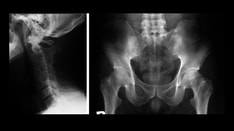Background
Iritis, or anterior uveitis, is the most common form of intraocular inflammation. It is a common cause of a painful red eye. Inflammation of the iris may appropriately be termed iritis, whereas inflammation of the iris and the ciliary body is called iridocyclitis. Iritis may be subdivided into 2 broad categories: granulomatous and nongranulomatous. Iritis may be recurrent.
This article discusses nongranulomatous iritis, although iritis due to a granulomatous disease process may have a nongranulomatous appearance. For information about granulomatous disease, see Uveitis, Anterior, Granulomatous.
The most common form of nongranulomatous anterior uveitis is acute anterior uveitis (AAU), which is associated with the human leukocyte antigen (HLA)–B27 allele in one half to two thirds of cases. However, only 1% of people who carry the HLA-B27 allele develop acute anterior uveitis. [1]
Pathophysiology
The exact pathophysiology is not known. Inflammation of the iris and the ciliary body causes a breakdown of the blood-ocular barrier. This condition allows both protein and WBCs to extravasate into the aqueous, resulting in the signs of cell and flare which are typical of iritis. Frequently, the cause is idiopathic, but certain ocular and systemic diseases may be the underlying cause of the iritis. [2]
In the case of HLA-B27–associated acute anterior uveitis, speculation about molecular mimicry has unsubstantiated in humans. Certainly, recent interest in the microbiome (gut and other resident micro-organisms) in disease, as well as the observation that rats transgenic for HLA-B27 do not form ankylosis and other evidence of disease until the gut is colonized, suggest a possible connection to disease. A close relationship between asymptomatic (subclinical) ileocolitis has been demonstrated in patients with recurrent uveitis. [3]
Epidemiology
Frequency
United States
Iritis is the most frequent form of uveitis encountered by ophthalmologists. In one community-based study, anterior uveitis accounted for more than 90% of all cases of uveitis. The annual incidence rate is approximately 8 cases per 100,000 population. [4]
International
No particular geographic distribution for iritis has been noted.
Mortality/Morbidity
Morbidity arises from iritis and any associated disease process, if present.
Episodes of acute anterior uveitis are often associated with pain, photophobia, decreased vision, and the need for follow-up visits, all of which affect quality of life.
Patients may develop posterior synechiae, and, if severe, a secluded pupil and subsequent angle-closure glaucoma may result from pupillary block.
Associated ocular complications (eg, cataract, glaucoma, macular edema, hypotony) may result in severe vision loss.
Race
No significant racial differences exist for non-granulomatous iritis. HLA-B27–associated anterior uveitis is more common in whites.
Sex
No significant sexual differences exist. However, the male-to-female ratio of ankylosing spondylitis, which is a common association with non-granulomatous iritis, is 3:1. [5]
Age
Iritis may develop in persons of any age but most commonly in the fourth and fifth decades of life.
-
Fine keratic precipitates in a patient with ankylosing spondylitis–associated acute anterior uveitis.
-
Small stellate keratic precipitates with fine filaments in a patient with Fuchs heterochromic iridocyclitis.
-
Acute anterior uveitis with plasmoid aqueous and hypopyon in a patient with ulcerative colitis.
-
Fuchs heterochromic iridocyclitis with cataract and iris heterochromia.
-
Iris atrophy in a patient with herpes simplex virus–associated anterior uveitis.







